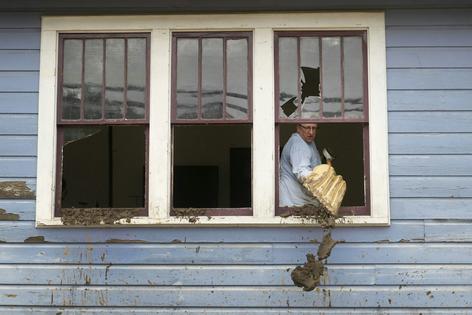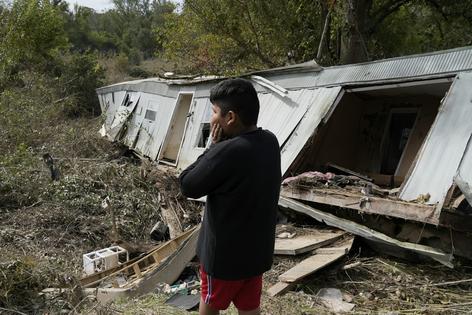People displaced by hurricanes face anxiety and a long road to recovery, US census surveys show − smarter, targeted policies could help
Published in News & Features
The trauma of natural disasters doesn’t end when the storm or wildfire is gone, or even when communities are being put back together and homes have been rebuilt.
For many people, being displaced by a disaster has long-term consequences that often aren’t obvious or considered in disaster aid decisions.
We study public policy and disaster response. To get a better understanding of the ongoing challenges disaster victims face – and how officials can respond more effectively – we analyzed U.S. Census Bureau surveys that ask people nationwide about their disaster displacement experiences, as well as their stress and anxiety.
The results show how recovery from disasters such as hurricanes, wildfires, tornadoes and flooding involves more than rebuilding, and how already vulnerable groups are at the greatest risk of harm.
The Census Bureau’s Household Pulse Survey has been continually collecting data on people’s social and economic experiences since 2020. Since late 2022, it has specifically asked respondents whether they had been displaced from their homes because of natural disasters.
Nearly 1.4% of the U.S. adult population reported being displaced in the previous year, equating to more than 3 million Americans. The most common cause of those displacements was hurricanes, responsible for nearly one-third of the displacements.
Some groups faced a higher chance of being displaced by a natural disaster than others.
The likelihood of displacement was above average for people with incomes of less than $50,000 (1.9% of that population was displaced), disabled people (2.7%), African Americans (2.3%) and Latinos/Hispanics (1.8%), as well as for those who identified their sexual orientation as gay/lesbian, bisexual, something else, or said that they don’t know (2.2%).
The problems of displacement go beyond immediate evacuation. People may have to stay in temporary shelters such as stadiums, churches or disaster relief areas. During this time, they are likely unable to work and earn income. Others with nowhere else to go may return to still-damaged homes after the storm passes.
Many people who were displaced by a hurricane faced weeks without power or lacked access to enough food, clean water or other basic necessities. After being displaced, 64% of adults said they lacked electricity some or all of the time, 37% lacked enough food, 29% lacked drinkable water, and 25% indicated that they experienced unsanitary conditions some or all of the time.
Going without enough clean water or electricity can expose people to diseases and other health risks, on top of the stress of dealing with the damage, displacement and uncertainty about the future.
About 36% of those displaced were out of their homes for more than one month. Nearly 16% of them indicated that they never were able to return. Vulnerable groups, especially people of color and disabled people, were least likely to return home quickly.
Being displaced also piles on stress and creates instability. People displaced by storms may bounce among family members’ houses, hotel rooms or even vehicles as they wait to return to a home that has been damaged. They may have lost jobs or be unable to find temporary housing nearby, creating feelings of uncertainty about the future.
People who feel that their safety or security is threatened are more likely to experience mental stress and, potentially, post-traumatic stress disorder. The effects can accumulate over time and have long-term health consequences. Chronic stress can contribute to hypertension and heart disease and make rebuilding lives even harder as people struggle with more than just the damage around them.
The Household Pulse Survey also collects information on the symptoms of anxiety and depression that individuals experience.
Among those who have been displaced by a hurricane, 38% indicated experiencing generalized anxiety, a much higher percentage than the 23% of the population who did not experience displacement.
Similarly, 33% of those who were displaced experienced symptoms of major depressive disorder compared with 18% of the population who did not face displacement.
The survey results highlight the need to restore water and power to homes quickly after disasters. The results also point to prioritizing communities that are least able to afford being displaced.
Studies have shown that low-income communities often wait longest for power to be restored after hurricanes. The survey shows that these communities and other disadvantaged groups also face higher levels of displacement after disasters.
Beyond the immediate responses to a disaster, the survey suggests that federal, state and local policymakers will have to consider long-term assistance for both housing recovery and for health care.
Currently, the Federal Emergency Management Agency primarily focuses on providing short-term disaster relief. The large majority of its disaster funding goes toward evacuation, temporary shelter for people displaced, emergency supplies, insurance and rebuilding community infrastructure. While other federal programs provide rebuilding assistance for individuals, they don’t sufficiently address the long-term challenges, in our view.
Some ways government could help include providing targeted cash transfers to ensure vulnerable households can rebuild, investing in affordable and climate-resilient housing that can limit losses in future disasters, and funding long-term mental health services for disaster survivors at free or reduced cost.
As the climate warms, extreme storms are becoming more common in every region of the country. That’s raising the risks and the need for policymakers to prepare communities to limit harm from disasters and recover afterward. We believe rebuilding lives will require support long term, both for building more resilient homes and infrastructure and for recovering from the trauma.
This article is republished from The Conversation, a nonprofit, independent news organization bringing you facts and trustworthy analysis to help you make sense of our complex world. It was written by: Trevor Memmott, UMass Boston and Christian Weller, UMass Boston
Read more:
Evacuating in disasters like Hurricane Milton isn’t simple – there are reasons people stay in harm’s way
Health risks are rising in mountain areas flooded by Hurricane Helene and cut off from clean water, power and hospitals
Wildfire risk is soaring for low-income, elderly and other vulnerable populations in California, Washington and Oregon
Christian Weller is affiliated with the Center for American Progress (Senior Fellow)
Trevor Memmott does not work for, consult, own shares in or receive funding from any company or organization that would benefit from this article, and has disclosed no relevant affiliations beyond their academic appointment.











Comments